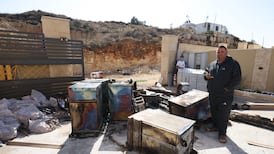A picture of a trench lined with sandbags is on the screen. Physics teacher Ayda Elsayed Ahmed (55) uses it to illustrate Newton’s laws of motion – explaining the “directions and the spaces”, how “force” can become “less”.
This example was already on the Palestinian physics curriculum long before the bombardment of Gaza, she says, but understanding it has perhaps taken on a new form of urgency for her students, trapped inside the blockaded enclave for close to two years now; desperate to learn, but also to survive.
Before the Hamas-led attacks of October 7th, 2023, more than 625,000 students in Gaza and 22,000 teachers attended 815 schools in 564 buildings across the enclave, according to the Global Education Cluster, which comprises of representatives from many international NGOs and is steered by Unicef and Save the Children.
In June this year, a UN Human Rights Council commission of inquiry found that Israel had “used air strikes, burning and controlled demolitions to damage and destroy more than 90 per cent of the school and university buildings in Gaza, creating conditions where education for children, including adolescents, and the livelihood of teachers have been made impossible”.
READ MORE
It said attacks on educational facilities had been war crimes, which included the killing of civilians sheltering in schools, and that “Israeli soldiers recorded and distributed videos in which they mock Palestinians and Palestinian education, before destroying schools and universities”.
This was “indicative of the Israeli security forces’ intent to destroy these facilities to curtail Palestinians’ access to education in the long-term”.
More than 658,000 children in Gaza have had no schooling for 20 months, the commission said.
Israel says Hamas operates in civilian areas, with Binyamin Netanyahu’s office last week saying Hamas “openly uses civilians as human shields” and “uses schools and kindergartens to store weapons”.
[ Sally Hayden: Stranded fathers describe anguish over children in GazaOpens in new window ]
An ever-growing number of international lawyers and experts call what is happening in Gaza a genocide. More than 60,000 people have already been killed there, according to Gazan health authorities, including about 18,500 children. While ensuring access to education may seem secondary compared to mass killing, Palestinian teachers say Gazan students remain desperate to learn.
In April 2024, a UN Human Rights Council panel of experts also said it may be “reasonable to ask if there is an intentional effort to comprehensively destroy the Palestinian education system [in Gaza], an action known as ‘scholasticide’,” adding “when schools are destroyed, so too are hopes and dreams”.

‘I have a responsibility to support them’
Ahmed was first contacted by Gazan students through social media early last year. The physics teacher of 25 years is based in the city of Dura, in the occupied West Bank. She added the students to a WhatsApp group, saying she was willing to give them physics courses online.
“I was really affected by what’s happening in Gaza. Some of my students contacted me and told me sad stories about their lives. They showed me their destroyed houses, and so I was emotionally affected and I started giving them psychological support before I started teaching them. I have a responsibility to support them, to help them to pass these miserable conditions,” she says, sitting on a sofa in her family home.
Gaza is about 44km (27 miles) west of Ahmed’s house, but the enclave is under a complete blockade.
As she speaks, the sound of a warplane rumbles above followed by a distant explosion – they can sometimes hear the bombing of Gaza from the West Bank, Ahmed says.
Most of her original students were Gazans displaced abroad: usually in Egypt, but also Russia, Norway and Germany. “I searched for students who needed help and gave them my number,” Ahmed says.
She held three online intensive courses – in June, August and December 2024 – managing to finish the whole of the final year physics course in a month, with multiple sessions a day reaching up to 100 students, she says.
They attended classes through Microsoft Teams, took tests through Google Forms and watched as Ahmed used a virtual physics lab to carry out experiments. Some later passed formal exams in Egypt, while others are at least better prepared for whenever they get the chance.
In January 2025, Ahmed joined about 25 West Bank-based teachers involved in a more official programme offering “virtual schools” for Gazan students, supported by the Palestinian education ministry in Ramallah.
She says teachers inside Gaza have made impressive efforts to teach classes in tents, but “it’s crowded, a lot of noise, [the students] can’t hear anything and they don’t understand things”. She calls for those teachers to get more financial support and materials such as tablets, pens and paper.
Through the virtual school, Ahmed taught 480 students in Gaza online. She received a stipend from the Palestinian Authority for some of that period, but said she would take part either way. “We didn’t join for money, we joined to help our students.”

Dr Salem Abu Musleh, the co-ordinator of the Palestine Astrophysics Programme, who now teaches in tents in Khan Younis, says in-person learning is still the best option for many. Nearly 80 per cent of Gazan students do not have access to stable internet from Palestinian providers, relying instead on weak, cheaper connections from service providers in tents, and must often travel long distances to get it, he says. Many are without a mobile phone, laptop or electricity – or have just one mobile phone per family. The internet regularly goes down.
But virtual schools can be more “comfortable” for those with that option, Ahmed says. “I try to overcome the problem of when the internet is not available. I record my classes and I have a YouTube channel ... I have a special page on Facebook for the students of Gaza.”
Starvation badly affects her students, with one in three Palestinians in Gaza going without food for days at a time, according to the UN.
“They are very, very, very hungry. My students told me while studying they [can’t even get] a cup of tea with a spoon of sugar. [They ask] ‘how can I study and do my homework without eating?’ This is severe hunger they face, they’re being pushed into starvation.”
Some parents contact Ahmed too. “A mother told me her daughter is a student, she can’t go to where the charging point for mobiles is as she hasn’t eaten for one week, she’s so weak.”
‘It was some kind of light through the darkness’
Suheir Hussein Abu Arqub (55) – an English teacher in the West Bank for the past 24 years – began teaching virtual school in October last year, alongside her regular secondary school position in Dura.
“At first, the situation was hopeless and we were very sad for the students, we thought they lost their future ... but when the idea of virtual schools appeared it was some kind of light through the darkness. It was really an attempt to save what you can save,” she says.

“The idea is to keep the students in contact with schools, books, teachers and knowledge, education ... We don’t want to lose hope. We want any kind of opportunity to give them light ... Certificates now are not important, what’s important is to give them necessary knowledge that will help them in the future.”
Arqub says she teaches as many as 1,700 students in Gaza across various groups, with up to 120 logging in for each class. “Not all the students are able to connect ... because they have internet problems. Sometimes electricity is cut most of the day, some don’t have mobiles or laptops ... In periods where there are massive bombing and destruction the number [joining classes] becomes much less.”
She says students create WhatsApp groups to help each other and exchange homework. They have access to books online.
But, even when in class, the horrors they are experiencing are impossible to forget.
“Displacement is a very hard situation for students, they say they keep all the time moving from place to place so this interrupts their continuous learning. Some lost close relatives.
“I have a student who talked to me, he lost his brother ... He said they were displaced and then when they returned to their house the house was damaged, but they don’t have another place to live so they live in it and fear it will collapse on them.”
During one lesson, she recalls, a student started screaming, saying his area was being bombed and he was going to move to a safer place. But he added: “Please Miss, don’t forget me”. Another student messaged from hospital, saying “my father was killed and my mother was killed and I’m wounded in hospital but I want you to send me your homework and tell me what you did when I was away.”
A student named Mohammed was killed, Arqub says. “He did well on his exam ... When he died the students from the area where he lives [told] the principal ... I cried.”
About 1,500 Gazan students sat high school matriculation exams – “tawjihi” – on July 19th, according to Palestinian news agency Wafa. Those exams had been postponed since December 2023, and took place electronically, in organised venues or online from wherever those taking part could find an internet connection and charged device.
Ahmed would like to see more students given the opportunity to sit their final exams but recognises that “it depends on the security situation”.
Writing on Al Jazeera’s website this week, Ahmad Abushawish, a student still waiting to sit his, said the exams are not only a “milestone”, but also carry “cultural and emotional weight” as a “symbol of perseverance.”
“In a place where the occupation closes nearly every door, education is able to keep a few doors still open,” he wrote.
Despite all of their challenges, Ahmed says she has never seen such dedicated students. “I feel the students of Gaza deserve this because they insist on learning, they search for the knowledge ... They are very thirsty for education, they think this is their hope to overcome this miserable situation. They were very ambitious and hopeful in spite of all this.”
Next, Ahmed says, her students are keen to join virtual universities “to be connected with education forever. They’re very clever, creative, they think outside the box. They deserve it”.





















